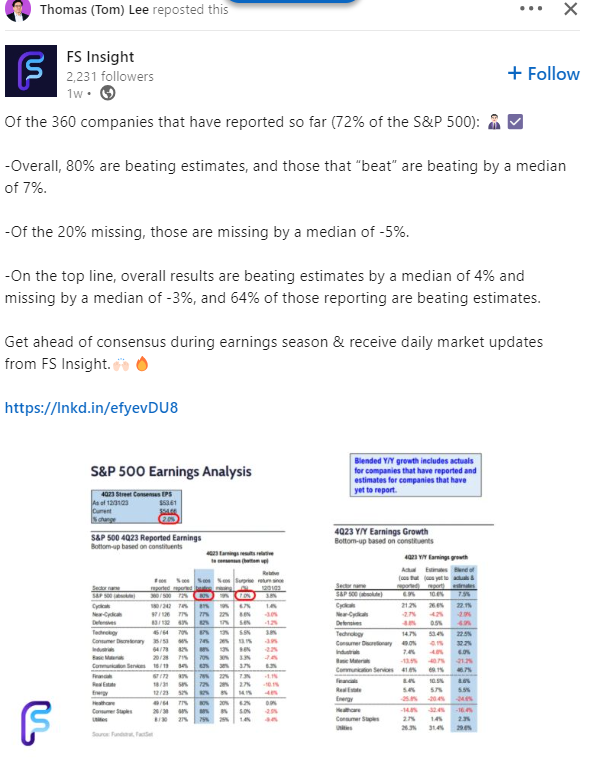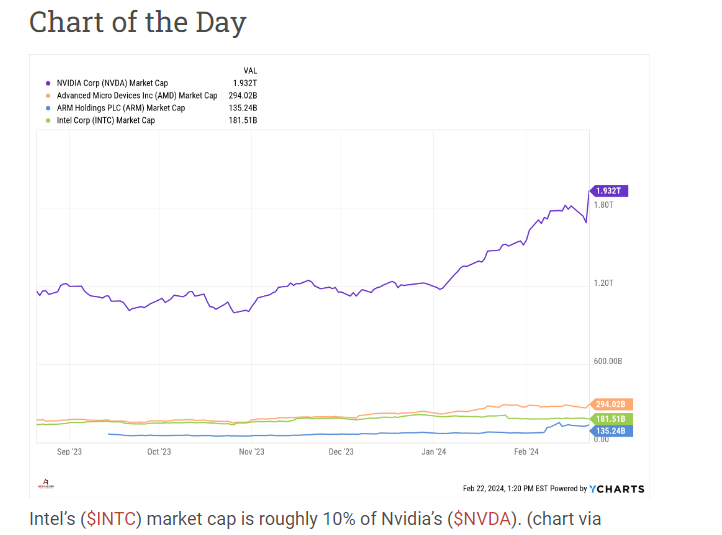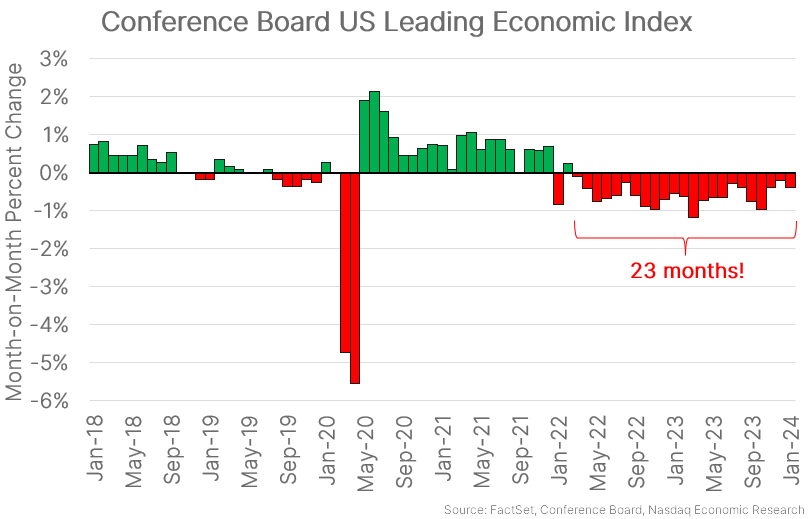1. Follow-Up to Yesterday’s #1-Looks Like Hedge Funds Pulling Back on Tech
Dave Lutz Jones Trading Figures showed that after piling into tech stocks in the weeks before Nvidia Corp.’s earnings, hedge funds are now cashing out and selling at the fastest pace in seven months. Professional managers offloaded their positions for four straight sessions last week, including Thursday, the day after Nvidia posted results, according to data from Goldman’s prime-brokerage unit. The intensity of the selling ranks in the 98th percentile of the past five years.

The data suggests traders are booking profits on their tech wagers after a six-week buying streak and putting that extra cash into less volatile stocks, such as consumer staples. Companies that make household products saw the most net buying in 10 weeks, according to Goldman’s prime brokerage
2. S&P Positive 15 Out of 17 Weeks
Jim Reid Deutsche Bank We are in rarefied air in terms of the relentless risk rally since the end of October. Today’s CoTD is adapted from my colleague Henry Allen’s latest Mapping Markets (link here) and shows that the S&P 500 has now been up for 15 out of the last 17 weeks. This is the first time since 1989 that’s happened, and before that you’d need to go back to 1972 for such a run. If we get yet another advance this week, it would be 16 out of 18 for the first time since 1971, the joint record in an 18-week run.
Interestingly, looking at all such 15/17 week runs, the median price performance in the next 13 and 26 weeks is +2.0% and +5.5%, respectively, which are both high relative to an annual price move of around 6% over the last 100 years. So there is no specific evidence, from history, of mean reversion once you see one of these runs.

3. Fear and Greed Index at Extreme Greed

https://www.cnn.com/markets/fear-and-greed
4. Bitcoin 21% from an All-Time High

5. Grayscale Ethereum +43% in One-Month

ETHE Making Run at 2021 Levels.

6. Private Equity Secondaries Market Data
Secondaries Investor Blog

7. Private Equity Growth vs. Stock Market Shrink
Number of Stocks in Wilshire 5000

8. Private Equity Funds Operating in Real Estate Sitting on $544B in Cash
Cash-Flush Buyers Dip into Distressed Commercial RE
Some data shows that global real estate funds operated by private-equity firms held $544B in cash at the end of 2Q 2023, up from $457B at the end of 2Q 2022.
NEW YORK – Regional banks and other lenders have grown concerned about the volatility in commercial real estate, but investors are poised to scoop up distressed properties with cash.
Preqin data show that global real estate funds operated by private-equity firms held $544 billion in cash at the end of 2023’s second quarter, up from $457 billion at the end of 2Q 2022.
The pressure is on for office building, hotel, and apartment building owners, as higher debt-service costs are hitting those with floating rate debt. For example, Harbor Group International spent more than $600 million over the last year on seven apartment building developments, two of which are in Palm Beach, Florida, but some of those apartment buildings were not filling up as quickly as expected.
Richard Litton, president of Harbor Group, said, “Given the pressure on regional banks, those extension options were not necessarily available to developers. Now, investors are ready to either buy the properties or offer owners rescue capital for preferred returns.”
MSCI Real Assets data found that by the end of 2023, commercial property distress totaled $85.8 billion, up from $56.9 billion at the end of 2022 and the highest level since the third quarter of 2013.
Distress is likely to continue, forcing owners to refinance, particularly the over $2.2 trillion in commercial mortgages scheduled to mature between 2024 and 2027, reports Trepp.
However, with the availability of capital from funds and other resources for distressed assets, the struggles of the commercial property market are not near the levels of the 2008-2009 financial crisis.
Source: Wall Street Journal (02/12/24) Grant, Peter
9. Tesla rival BYD launches electric supercar that could take on Ferrari — for $233,000-CNBC
Sophie Kiderlin@IN/SOPHIE-KIDERLIN-B327B914A/@SKIDERLIN
KEY POINTS
- Chinese automaker BYD this weekend unveiled a new electric supercar that can hit speeds similar to high-end models by industry giants like Ferrari.
- The U9 will be released as part of BYD’s luxury brand Yangwang, which was introduced last year.
- BYD is a key competitor for Tesla as competition in the global electrical vehicle market runs hot.
Chinese automaker BYD this weekend unveiled a new electric supercar that it says can hit speeds similar to high-end models produced by industry giants like Ferrari.
The U9 supercar will be part of BYD’s luxury brand Yangwang, which was only introduced last year and has launched two other vehicles.
According to BYD, the U9 will be able to reach a top speed of 309.19 kph, or 192.12 mph. It will also be able to accelerate to 100 kph within 2.36 seconds.
This is comparable to supercars produced by long-established brands like Ferrari, whose hybrid SF90 Stradale model can accelerate to 100 kph in 2.5 seconds, according to the company’s website.
Prices for the U9 will start from 1.68 million yuan ($233,424) and deliveries are due to begin this summer, BYD said in a press release.
10. If you have a friend who uses any of these 8 toxic phrases, it may be time to ‘move on’: Psychologist
Marisa G. Franco, Contributor@DRMARISAGFRANCO
Friends are the cornerstone of a fulfilling and happy life. But some friendships can veer into toxicity, leaving emotional scars that make us want to withdraw altogether.
As a psychologist and expert in human connection, belonging and friendship, I help people recognize the signs of toxic relationships. But as my fellow friendship expert Danielle Bayard-Jackson argues, the most toxic friends often use crafty and underhanded forms of aggression.
Here are eight phrases that will help you spot even subtle signs of a toxic friendship:
1. ‘You’re too sensitive.’
When friends say “you’re too sensitive,” they imply that your feelings aren’t valid and that there’s something wrong with you for having them.
But expressing your emotions is a healthy part of any friendship, and being told you’re too sensitive may indicate your friend lacks empathy.
2. ‘I was just joking. Can’t you take a joke?’
Good friends are responsive and try to meet your needs. When you tell a friend you’re hurt, responsiveness looks like them trying to understand why and adjusting their behavior.
In a toxic friendship, they may instead say things like “Can’t you take a joke?” as a defense to camouflage hurtful comments and avoid accountability.
3. ‘You’re lucky to have me as a friend.’
Healthy friendships are built on equality. You’re both invested and neither of you is viewed as better than the other.
If you constantly hear your friend asserting their superiority or suggesting you should be grateful for their presence, it may be a sign of an imbalanced relationship in which you’re not valued.
4. ‘I miss the old you.’
Friends should allow you to be who you are, whether or not it fits their personal values, and encourage you to change and grow.
If your friend expresses discomfort with positive changes or, worse, undermines your progress, it could be a sign that you’ve outgrown the friendship or that your friend doesn’t have your best interests in mind.
5. ‘You owe me.’
While reciprocity is important, if a friend expects you to repay everything they offer, it may mean they see the relationship as transactional.
As you get close to someone, you begin to include them in your sense of self, so what hurts them hurts you and what makes them happy makes you happy. That’s why good friends feel comfortable being generous.
6. ‘I wonder why they gave you that promotion.’
Having a friend who downplays your accomplishments or tries to one-up your success (e.g., “Well I just got a big raise”) undercuts your confidence and joy.
In healthy friendships, friends engage in something called “capitalization,” amplifying your joy by cheerfully exclaiming congratulations or taking you out to celebrate.
7. ‘I’m sorry you feel that way.’
True reconciliation requires each party to recognize the harm they caused. When a friend apologizes because you feel a certain way, they imply that the problem is your feelings rather than their behavior.
If expressing your concerns or setting boundaries is met with dismissive comments like this one, your friend isn’t taking accountability for their impact on you.
8. ‘…’ (as in nothing, they just ghost you)
Losing a friendship often triggers something called “disenfranchised grief,” an experience that occurs because society trivializes friendship and doesn’t legitimize the gravity of the loss. That grief is compounded when you don’t even know why a friend is pulling away.
Getting ghosted, one study found, makes you feel hurt and sad and lowers your self-esteem. Even if they want to end a friendship, friends should show regard for you by telling you explicitly.
Diagnosing and dealing with a toxic friendship
Of course, no single phrase alone can diagnose a friendship as toxic. So be sure to consider these phrases within the larger dynamics by asking yourself questions like:
- Do they show up when I’m in need?
- Do they want the best for me?
- Is there a balance where each of our needs are met?
If you find these phrases reflect a larger toxic dynamic, it may be a sign to pull back, set boundaries, or have an honest conversation and move on.
Marisa G. Franco is a psychologist, professor at The University of Maryland, and the New York Times bestselling author of ”Platonic: How The Science of Attachment Can Help You Make — and Keep — Friends.” Her work has been featured in Psychology Today, The New York Times, The Telegraph and Vice.

































